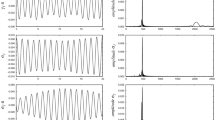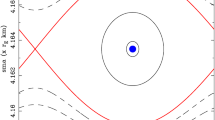Abstract
In this article, we investigate the mathematical part of De Sitter’s theory on the Galilean satellites, and further extend this theory by showing the existence of some quasi-periodic librating orbits by application of KAM theorems. After showing the existence of De Sitter’s family of linearly stable periodic orbits in the Jupiter–Io–Europa–Ganymede model by averaging and reduction techniques in the Hamiltonian framework, we further discuss the possible extension of this theory to include a fourth satellite Callisto, and establish the existence of a set of positive measure of quasi-periodic librating orbits in both models for almost all choices of masses among which one sufficiently dominates the others.


Similar content being viewed by others
Notes
Readers comparing this article with de Sitter (1909) should be careful that De Sitter took \(R=-F_{pert}\).
We shall eventually only consider persistence of invariant objects under \(O(\varepsilon )\)-perturbations. The restriction is made to adapt to this.
Note that, in de Sitter (1909), De Sitter took (for small eccentricities) \(\epsilon _{i}=e_{i}/2, \, i=1,2,3\) instead of \(e_{i}\) in the expression of \(F_{res}\).
In de Sitter (1909), De Sitter stated this as a necessity. This is not evident at all.
We need to impose the assumption that these roots are distinct in order to guarantee that linearly stable periodic orbits can be continued to linearly stable ones for small parameters. De Sitter seems to have overlooked this point, though it does not change the result.
References
Arnold, V.I., Kozlov, V.V., Neishtadt, A.I.: Mathematical Aspects of Classical and Celestial Mechanics. Springer, Berlin (2006)
Broer, H.W., Huitema, G., Takens, F.: Unfolding of quasi-periodic tori. Mem. Am. Math. Soc. 83(421), 1–82 (1990)
Broer, H.W., Hanssmann, H.: On Jupiter and his Galilean satellites: librations of De Sitter’s periodic motion. Submitted (2016)
de Sitter, W.: On the periodic solutions of a particular case of the problem of four bodies. KNAW Proc. 11, 682–698 (1909)
de Sitter, W.: Outlines of a new mathematical theory of Jupiter’s satellites. Annalen van de sterrewacht te Leiden 12, 1–55 (1925)
de Sitter, W.: Jupiter’s Galilean satellites (George Darwin lecture). Mon. Not. R. Astron. Soc. 91, 706–738 (1931)
Féjoz, J.: Quasiperiodic motions in the planar three-body problem. J. Differ. Equ. 183(2), 303–341 (2002)
Féjoz, J.: Démonstration du théorème d’Arnold sur la stabilité du système planétaire (d’après Herman). Ergod. Theory Dyn. Syst. 24(5), 1521–1582 (2004). (Revised version)
Féjoz, J.: Mouvements périodiques et quasi-périodiques dans le problème des n corps. Habilitation à diriger des recherches. Université Pierre et Marie Curie-Paris VI, Paris (2010)
Féjoz, J.: The normal form of Moser and applications. preprint (in revision), (2011)
Féjoz, J.: Introduction to KAM theory. (2013)
Ferraz-Mello, S.: Dynamics of the Galilean Satellites-an Introductory Treatise. Mathematical and Dynamical Astronomy Series. Universidade de Sao Paulo, Instituto Astronomico e Geofisico, São Paulo (1979)
Hadjidemetriou, J.D., Michalodimitrakis, M.: Periodic planetary-type orbits of the general 4-body problem with an application to the satellites of Jupiter. Astron. Astrophys. 93, 204–211 (1981)
Laskar, J., Robutel, P.: Stability of the planetary three-body problem. Celest. Mech. Dyn. Astron. 62(3), 193–217 (1995)
Moulton, F.R.: Periodic orbits. Carnegie institution of Washington, Washington (1920)
Poincaré, H.: Les Méthodes Nouvelles de la Mécanique Céleste, vol. 1. Gauthier-Villars, Paris (1892)
Tisserand, F.: Traité de Mécanique Céleste, vol. 1. Gauthier-Villars, Paris (1889)
Tisserand, F.: Traité de Mécanique Céleste, vol. 4. Gauthier-Villars, Paris (1896)
Zhao, L.: Quasi-periodic solutions of the spatial lunar three-body problem. Celes. Mech. Dyn. Astron. 119(1), 91–118 (2014)
Acknowledgments
The manuscript was prepared during the stay of LZ in Johann Bernoulli Institute, University of Groningen as a postdoc. We thank the anonymous referees, Sylvio Ferraz Mello and Heinz Hanssmann for their careful reading of the manuscript and for their suggestions of improvements.
Author information
Authors and Affiliations
Corresponding author
Rights and permissions
About this article
Cite this article
Broer, H., Zhao, L. De Sitter’s theory of Galilean satellites. Celest Mech Dyn Astr 127, 95–119 (2017). https://doi.org/10.1007/s10569-016-9718-8
Received:
Revised:
Accepted:
Published:
Issue Date:
DOI: https://doi.org/10.1007/s10569-016-9718-8




